Introduction
In the world of data analytics, understanding cardinality in Power BI is not just a technical necessity; it is a critical factor that can elevate the effectiveness of data modeling and reporting. Cardinality defines the relationships between data entities, shaping how information is structured and interpreted.
By mastering the nuances of:
- one-to-one
- one-to-many
- many-to-many relationships
data professionals can create models that accurately reflect complex real-world scenarios, leading to more insightful analyses and informed decision-making.
This article delves into the intricacies of cardinality in Power BI, providing actionable strategies to tackle common challenges such as data inconsistencies and inefficiencies in report generation. With the right knowledge and tools, organizations can harness the full potential of their data, driving operational excellence and fostering a culture of data-driven insights.
Understanding Cardinality in Power BI: The Basics
The concept of power bi cardinality explained is fundamental in Business Intelligence, referring to the uniqueness of values within a relationship in a model. This document provides a detailed overview of power bi cardinality explained, which describes how many occurrences of one entity connect to occurrences of another, essential for precise information analysis and efficient information modeling. The concept of power bi cardinality explained includes three primary types in Power BI: one-to-one, one-to-many, and many-to-many.
Each type serves a distinct purpose in reflecting real-world scenarios and influences how data analysts design robust models. For example, a one-to-one (1:1) connection guarantees that one row in a dataset corresponds exactly to one row in another, illustrated by links such as student to student contact details. This connection is represented in ER diagrams by a single line linking the two entities, with perpendicular lines indicating mandatory associations, while optionality is denoted by an empty circle.
In contrast, many-to-many (M:N) relationships require an additional junction or link table to establish connections effectively, highlighting the complexity and necessity of understanding these relationships in information modeling. Understanding the power bi cardinality explained metrics is essential, particularly in cloud-native environments, as managing these metrics can significantly impact system efficiency and monitoring capabilities. Tackling common issues such as time-consuming report creation, inconsistencies, and the absence of actionable guidance can be accomplished by utilizing the capabilities of Business Intelligence tools like BI.
For instance, applying a governance strategy can help ensure consistency across reports, thereby reducing confusion and mistrust in the information presented. As emphasized by Stephen Watts from Splunk, high cardinality provides the flexibility to tailor monitoring and observability to specific needs, ultimately driving operational efficiency and empowering your organization to make informed decisions.
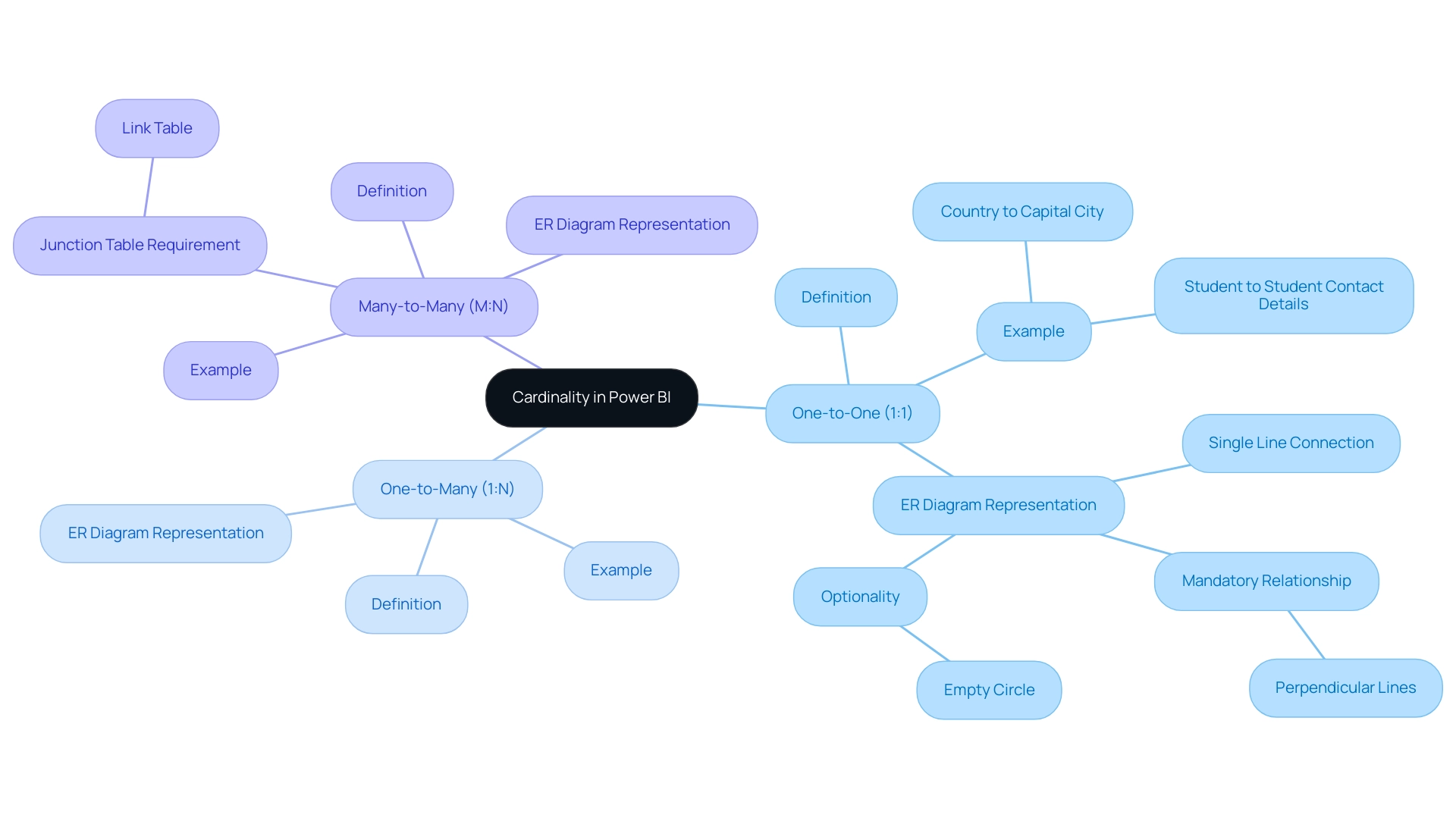
Exploring Types of Cardinality Relationships in Power BI
In Power BI, the concept of power bi cardinality explained is crucial for effective modeling, particularly when addressing frequent issues such as time-consuming report creation, inconsistencies, and the absence of actionable guidance. The main types include:
- One-to-One (1:1): Each record in one dataset corresponds to a single record in another dataset.
This relationship is often utilized to divide information into more manageable sections, particularly when one field is preferred over another. Gordon Linoff observes, > One instance where it is better to place such similar fields together is when one is clearly preferred and the other is the alternate.
A pertinent case study, titled ‘Feasible 1:1 Scenario: Optional Parts of Table,’ illustrates this concept through user information, where most users do not have specific settings, leading to many empty entries in the user record.
The suggested approach was to divide the user structure into two distinct entities: user and user_settings, enabling a more efficient arrangement while recognizing the complexity of retrieving information across both entities.
- One-to-Many (1:N): A single entry in one table can connect to numerous entries in another table, making this the most common association type in modeling.
Understanding the one-to-many cardinality is essential, as it ensures that analysts can construct precise models that represent the intricacies of their information, which is effectively power bi cardinality explained. Furthermore, understanding this connection can assist in simplifying report creation by minimizing errors and inconsistencies in data presentation. However, after forming a connection, it is important to remember that Excel must recalculate any formulas that reference columns from the associated datasets, which can be time-consuming.
Significantly, the limit on 2 will never change, but it should be possible to add or remove a person, which is pertinent to managing connections effectively.
- Many-to-Many (N:N): In this more intricate connection type, entries in both datasets can relate to multiple entries in one another.
Diligent oversight is essential to avoid ambiguity and maintain information integrity. A current trend in Business Intelligence suggests the creation of separate mapping tables to manage connections, allowing for greater flexibility in accommodating varying numbers of associated persons. By identifying and accurately applying these fundamental connections, analysts can enhance their models by understanding power bi cardinality explained, making them not only more precise but also more adaptable to the changing information landscape.
This understanding ultimately alleviates common reporting challenges, providing clearer, actionable guidance for stakeholders.
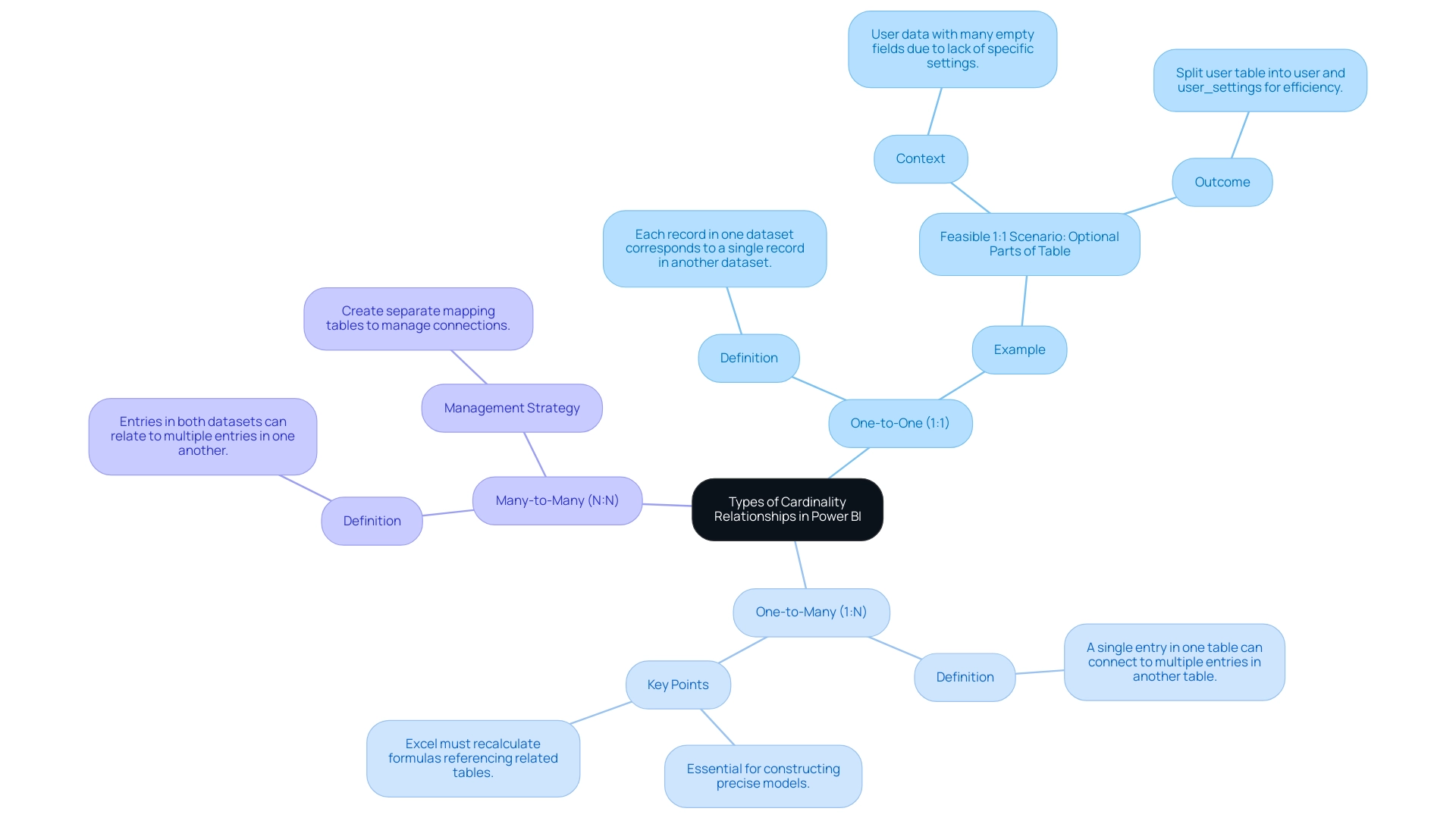
Creating and Managing Relationships in Power BI
Establishing effective relationships in BI is essential for constructing strong models that improve reporting abilities and tackle common challenges. Many professionals find themselves spending excessive time on report creation rather than leveraging insights from BI dashboards, leading to inconsistencies and confusion among stakeholders. A lack of a governance strategy can exacerbate these issues, making it essential to establish clear guidelines for data management.
To combat these challenges, it is essential to understand the four types of cardinality in Power BI, as power bi cardinality explained includes:
- One-to-many (1:*)
- Many-to-one (*:1)
- One-to-one (1:1)
- Many-to-many (:)
Here are the steps to establish a relationship:
- Open the ‘Model’ view and select the entities you wish to relate.
- Drag the field from one table to the corresponding field in another table.
- In the ‘Edit Relationship’ dialog, confirm that the cardinality type—such as one-to-one or one-to-many—is accurately set.
- Click ‘OK’ to finalize the connection.
For managing existing connections, access the ‘Manage Connections’ option, where you can edit, delete, or view connection details. Recent updates emphasize the importance of matching types for both columns in a relationship, particularly with DateTime columns, to prevent errors in your models. This adjustment can be made in the Query Editor.
A crucial understanding comes from Sam, who states,
Once you’ve fully grasped how to set up information models, you can easily create intuitive and significant BI reports.
Understanding these dynamics allows data analysts to optimize their models effectively and reduce the time spent on report generation. Significantly, the performance of filter propagation in BI varies by type of connection; one-to-many intra-source group connections are ranked the fastest, while many-to-many connections tend to hinder performance.
This performance ranking reflects the inefficiencies that can arise from poorly managed connections, leading to confusion among stakeholders. According to the case study on BI Model Connections: Performance Preference, many-to-many connections and cross-source group connections are slower, affecting overall model performance. By mastering these best practices and implementing a robust governance strategy, you can leverage the unique characteristics of your information to enhance overall efficiency and provide clear, actionable insights to stakeholders.
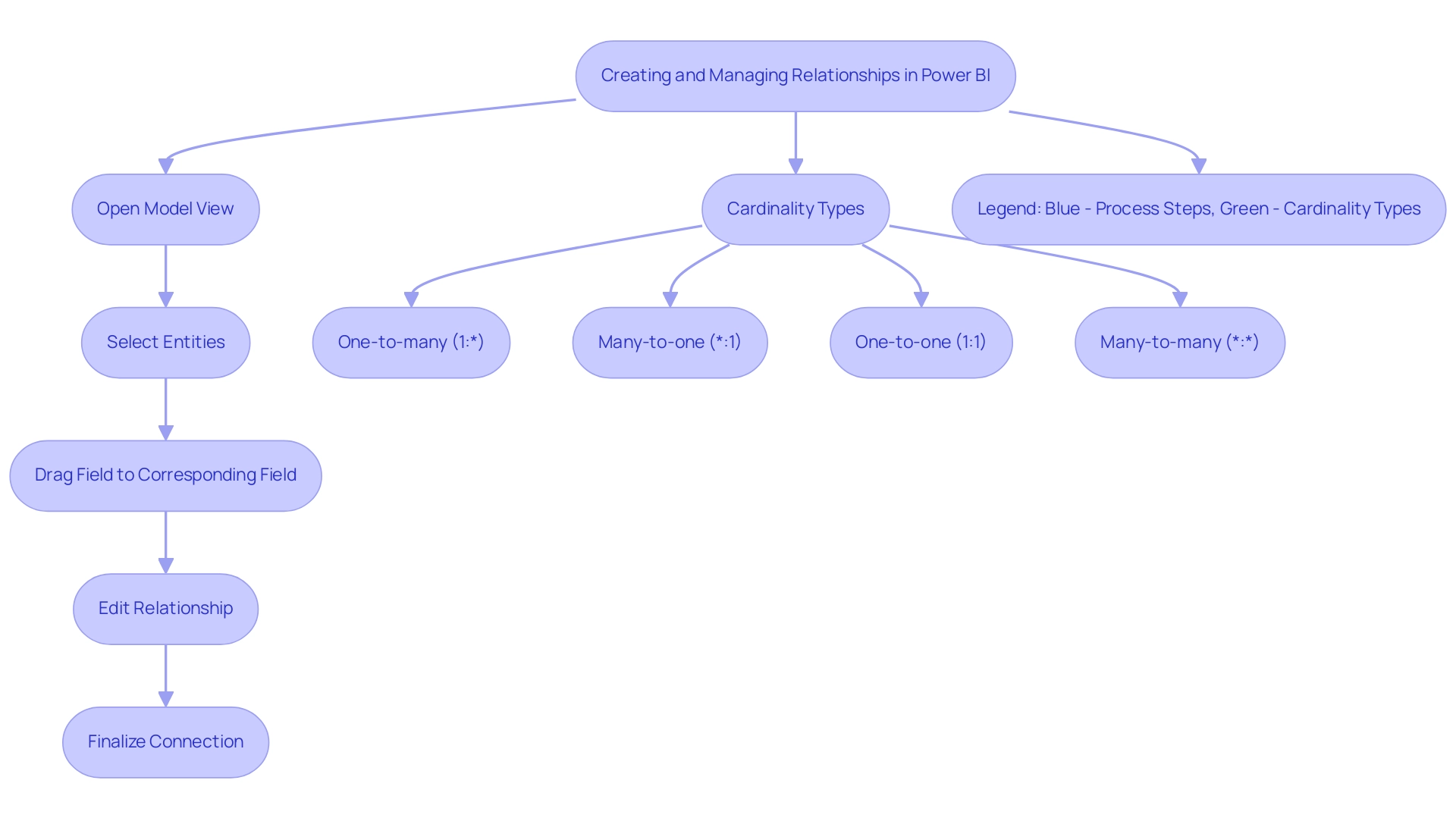
Troubleshooting Cardinality Issues in Power BI
Understanding power bi cardinality explained is crucial, as cardinality issues in Power BI, especially unclear connections, can significantly undermine the quality of your summaries and reporting, further exacerbating challenges related to poor master information quality, including inconsistent, incomplete, or flawed content. To tackle these challenges effectively, consider the following steps:
- Inspect your primary key fields for duplicate values, as these can lead to confusion in relationships and hinder your ability to leverage AI insights.
- Verify that the cardinality type—whether one-to-one, one-to-many, or many-to-many—is appropriately defined based on the characteristics of your information, as understanding the power bi cardinality explained is essential for accurate modeling.
- Utilize the ‘Manage Relationships’ tool to identify and resolve any conflicts that may occur in your model.
Addressing these concerns about power bi cardinality explained is crucial for enhancing the accuracy of your models, ultimately ensuring they reflect real-world business scenarios. Engaging with the community can provide valuable insights, as noted by Farhan Ahmed, a Community Champion, who emphasizes the importance of collaboration in problem-solving.
Additionally, don’t miss the early bird discount for the upcoming conference ending December 31, which offers a chance to learn from experts about Microsoft Fabric, Copilot, and Purview. Significantly, a recent conversation about confidentiality issues related to dataset uploads emphasizes the importance of grasping compliance requirements in BI. Case studies, like ‘Creating Connections in BI’, demonstrate that connections can be established automatically or manually, emphasizing the necessity to confirm their precision during the Query loading process.
By implementing these strategies, analysts can significantly enhance the reliability of their models and facilitate a smoother AI adoption process, addressing the common perception that AI projects are time-intensive and costly.
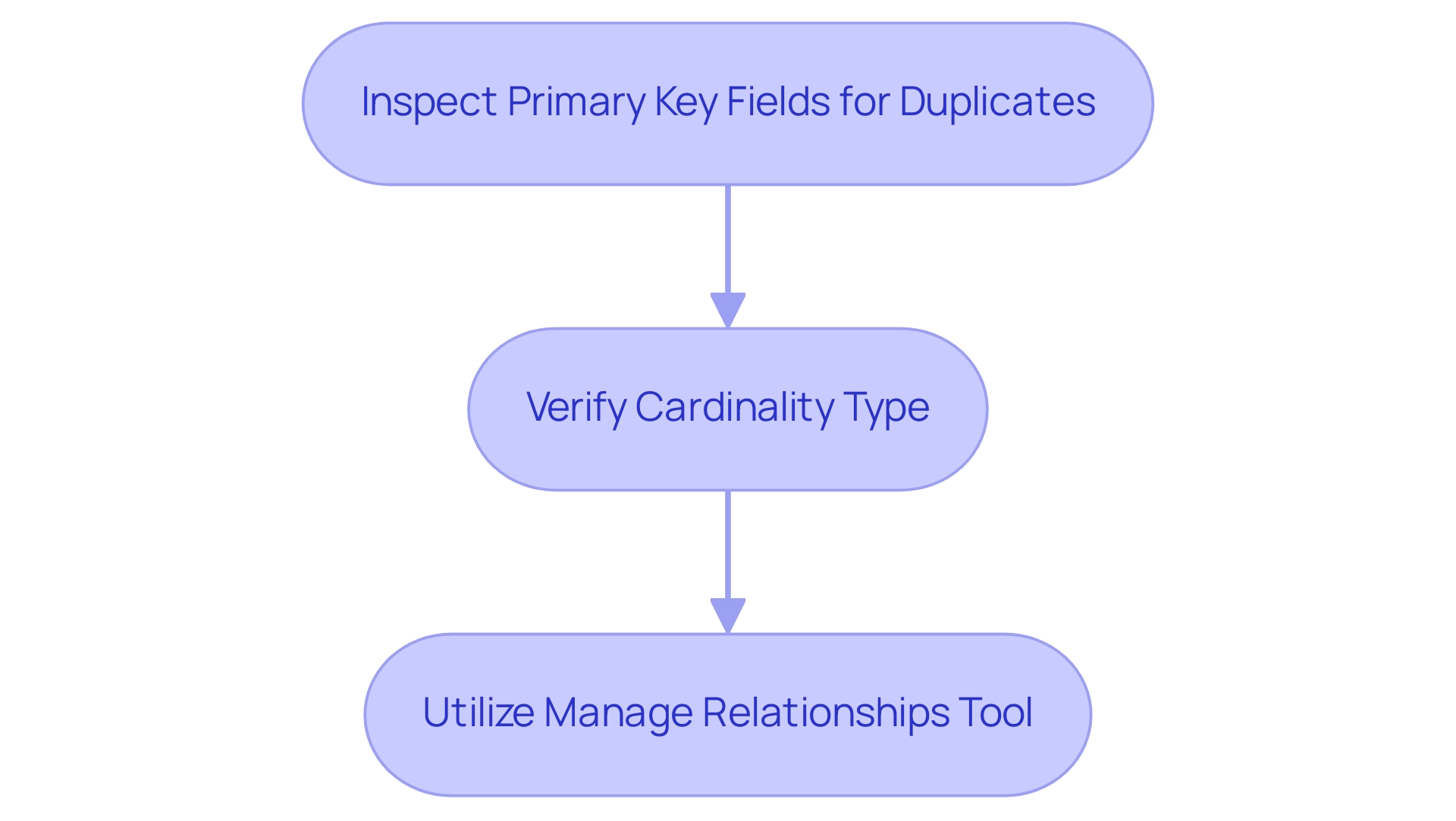
Advanced Relationship Management Techniques in Power BI
Advanced relationship management within BI is a strong approach that enables users to harness DAX (Data Analysis Expressions) for creating calculated columns and measures, thereby unlocking deeper insights from their data. With 2,724 users online, the relevance and popularity of BI among analysts is evident. By leveraging these capabilities, analysts can significantly enhance their reporting and analytical frameworks, especially with our 3-Day Power BI Sprint, which allows for the rapid creation of professionally designed reports.
Additionally, our General Management App ensures comprehensive management and smart reviews, further streamlining operations. An exciting advancement in this area is the use of virtual connections, which allows the creation of associations on-the-fly, providing flexibility without the need to alter the underlying information model. As one user noted, ‘I did just switch the relationships around which seems to have worked,’ highlighting the practical application of these concepts.
To effectively implement DAX, users can simply access the formula bar and compose expressions that define new calculations grounded in their existing datasets. This strategic application of DAX not only empowers analysts to develop dynamic reports and dashboards but also fosters improved decision-making. Moreover, as emphasized in the case study on optimizing performance with aggregations, these techniques are essential for efficiently managing large datasets, enabling organizations to analyze vast quantities of information without compromising speed or accuracy.
Such advancements in information modeling, alongside our EMMA RPA solutions aimed at overcoming outdated systems, significantly enhance operational efficiency. EMMA RPA not only automates repetitive tasks but also tackles staffing shortages and outdated processes, driving innovation and emphasizing the significance of investing in Power BI skills and RPA capabilities to gain competitive advantages in the continuously changing information landscape. Furthermore, by unlocking the power of Business Intelligence, organizations can transform raw data into actionable insights, enabling informed decision-making that drives growth and innovation.
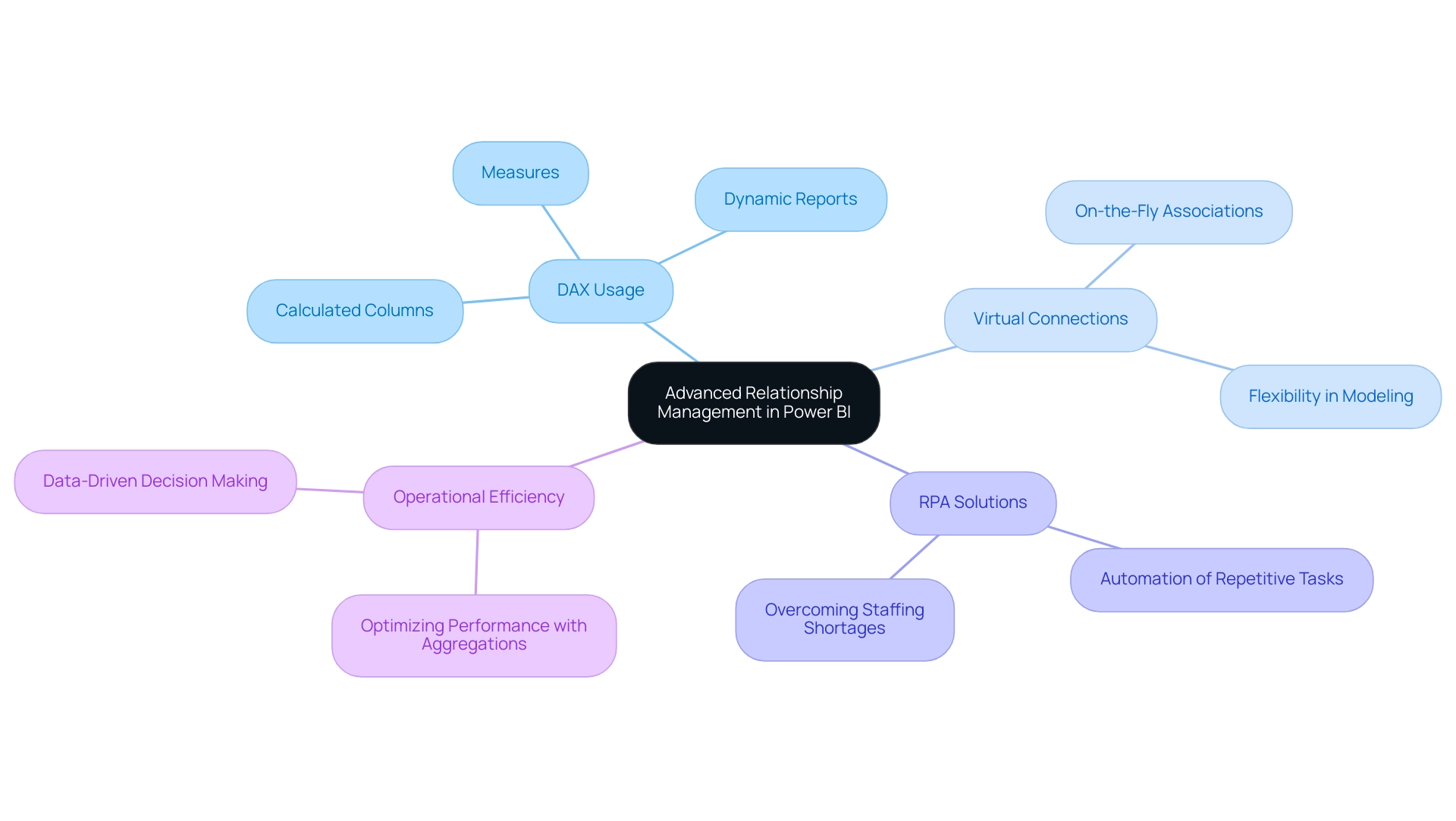
Conclusion
Mastering cardinality in Power BI is indispensable for data professionals aiming to enhance their data modeling and reporting capabilities. By understanding the different types of relationships—one-to-one, one-to-many, and many-to-many—analysts can create robust models that accurately reflect real-world scenarios. This knowledge not only streamlines report creation but also resolves common challenges such as data inconsistencies and inefficiencies.
Implementing effective relationship management strategies and leveraging advanced techniques like DAX can significantly optimize reporting processes. Establishing clear governance strategies is crucial to ensuring data integrity and fostering trust among stakeholders. Additionally, addressing cardinality issues proactively enhances the reliability of data models, providing a solid foundation for insightful decision-making.
Ultimately, the ability to navigate and manage cardinality in Power BI equips organizations to unlock the full potential of their data. By transforming complex datasets into clear, actionable insights, businesses can drive operational excellence and cultivate a culture of data-driven decision-making. Embracing these practices is not just beneficial; it is essential for thriving in today’s data-centric landscape.

